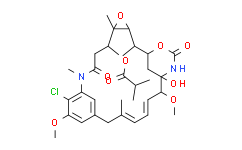| Cas No.: | 66584-72-3 |
| Chemical Name: | ansamitocin P-3 |
| Synonyms: | ansamitocin P-3;ANSAMITOCIN P 3;Maytansinol isobutyrate;(3E,5E,7R,84S)-14-chloro-10t,11c-epoxy-84-hydroxy-12c-isobutyryl-15,7r-dimethoxy-3,9c,11t,15-tetramethyl-(84r'H,86c'H)-15-aza-1(1,3)-benzena-8(4,6)-[1,3]oxazinana-cyclopentadecaphane-3,5-diene-82,14-dione;2'-De(acetylmethylamino)-2'-methylmaytansine;2'-De[acetyl(methyl)amino]-2'-methylmaytansine;Anasamitocin P-3;Ansamitosin P 3;Antibiotic C 15003P3;antibiotic C-15003-P-3;C-15003 P3,Ansamitocin P-3;C15003P3;Maytansinol butyrate;Nsc292222;Tam-330;NSC 292222 |
| SMILES: | COC1=C(Cl)C2N(C)C(=O)CC(OC(=O)C(C)C)C3(C)C(C(C)C4CC(NC(=O)O4)(O)C(OC)/C=C/C=C(C)CC(=C1)C=2)O3 |
| Formula: | C32H43N2O9Cl |
| M.Wt: | 635.14482 |
| Purity: | >98% |
| Sotrage: | 2 years -20°C Powder, 2 weeks 4°C in DMSO, 6 months -80°C in DMSO |
| Description: | Ansamitocin P-3 is a microtubule inhibitor. Ansamitocin P-3 is a macrocyclic antitumor antibiotic. |
| Target: | Microtubule[1] |
| In Vitro: | Ansamitocin P3 potently inhibits the proliferation of MCF-7, HeLa, EMT-6/AR1 and MDA-MB-231 cells in culture with a half-maximal inhibitory concentration of 20±3, 50±0.5, 140±17, and 150±1.1 pM, respectively. Further, Ansamitocin P3 is found to bind to purified tubulin in vitro with a dissociation constant (Kd) of 1.3±0.7 µM. The binding of Ansamitocin P3 induces conformational changes in tubulin. Ansamitocin P3 inhibits the proliferation of MCF-7, HeLa, EMT-6/AR1 and MDA-MB-231 cells in culture in a concentration dependent manner. Flow cytometric analysis of PI-stained cells suggests that Ansamitocin P3 inhibits the cell cycle progression of MCF-7 cells in G2/M phase. For example, 26, 50 and 70% of the cells are found to be in G2/M phase in the absence and presence of 50 and 100 pM Ansamitocin P3, respectively[2]. |
| Cell Assay: | MCF-7, EMT-6/AR1, HeLa and MDA-MB-231 cells are seeded in 96 well plates. Subsequently, cells are incubated with vehicle (0.1% DMSO) or different concentrations (1-1000 pM) of Ansamitocin P3 for 48 h in MCF-7 cells and 24 h for EMT-6/AR1, HeLa and MDA-MB-231 cells, respectively. The half maximal inhibitory concentration of cell proliferation (IC50) for Ansamitocin P3 is determined by sulforhodamine B assay. Four independent experiments are carried out in MCF-7 cells and three independent sets of experiments are performed in EMT-6/AR1, HeLa and MDA-MB-231 cells[2]. |
| References: | [1]. Kiso T, et al. Screening for microtubule-disrupting antifungal agents by using a mitotic-arrest mutant of Aspergillus nidulans and novel action of phenylalanine derivatives accompanying tubulin loss. Antimicrob Agents Chemother. 2004 May;48(5):1739-48. [2]. Venghateri JB, et al. Ansamitocin P3 depolymerizes microtubules and induces apoptosis by binding to tubulin at thevinblastine site. PLoS One. 2013 Oct 4;8(10):e75182. |






















